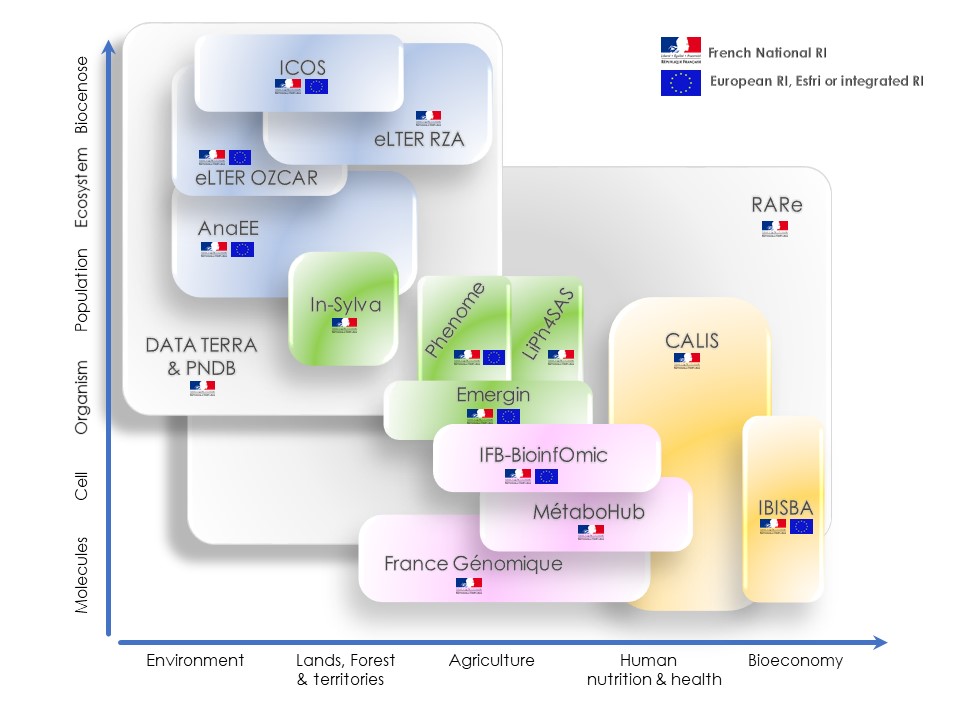Research infrastructures: open-access support networks
Provision of wide-ranging services
Research Infrastructures (RIs) are large-scale networks of facilities that provide high quality services to the scientific community, both public and private. They do so by researching and developing innovative processes at the cutting edge of science and technology. They also ensure that research data can be shared with others and that training is provided in related technologies.
INRAE’s research infrastructures support the Institute’s main thematic areas of activity : the environment, forestry and land management, agriculture, food and human health and the bioeconomy. They operate at all scales from the molecular to the biocenotic, ranging from genomics, enzyme production, the study of the properties of foods and agro-materials, plant phenotyping and agronomic experiments, to the observation of ecosystems and the Earth system as a whole, using satellite data for example.

INRAE’s network of RI facilities is linked to both national and European initiatives. Most of INRAE’s RIs already participate in French national networks. Others will either join these in due course or will become contributors to new RIs at this level. Involving many research establishments, these national infrastructures are coordinated through national associations and alliances such as AllEnvi, Aviesan, Athena and Ancre. INRAE coordinates six of the national Research Infrastructures. In their turn, some of the national RIs contribute to Europe-wide Research Infrastructures.
A mosaic of research facilities of various sizes and types
RIs are ‘distributed’ networked facilities, in other words, each operates across multiple sites and incorporates different types of establishment:
- UEs and IEs (Unités expérimentales, installations expérimentales). These experimental units and installations carry out agronomic testing and research.
- CRBs (centres de ressources biologiques). These are biological research and/or resource centres.
- OREs (observatoires de recherche en environnement). These research and environmental observatories are themselves grouped in networks (SOERE).
- PFAs. Analytical platforms that allow high speed data acquisition and processing using bioinformatics. These analytical platforms specialise in imaging, analytical chemistry, phenotyping and all the ‘omics’ (genomics, transcriptomics, proteomics, metabolomics).
- Technological platforms specialising in expanding and new fields of research: industrial biotechnologies, development of bioresources, bioprocesses, robotics.
Originally, INRAE’s research teams worked in experimental units that focused on agronomy. They have gradually diversifed their activities, broadening their scope on the one hand to include the observation of ecosystems while, on the other, specialising increasingly in research at molecular level as the fields of genomics and imaging have grown.
Currently, INRAE has around 200 facilities working in one or other of these two fields, of which 65 have now been formally designated as ISCs (collective scientific facilities) by the Institute. Most of its RIs are made up of these ISCs, some of which have also been designated at national level through the IBISA system (infrastructures in biology, health and agronomy https://www.ibisa.net/# ). Most of INRAE’s analytical platforms and biological resource centres have these designations.
Building an e-infrastructure
A multi-partner e-infrastructure is to be set up to contribute to the French Data Terra RI, which provides a data and service hub for the earth sciences. This will make it posible to include agronomic and food data in the evidence base for scientific projects that seek to increase our understanding of the functioning of agroecosystems and, more generally, the ‘Terra System’ as a whole. This e-infrastructure will also allow links to be made with human health, both individual and public, covering nutritional health, toxicology and ecotoxicology, zoonoses, etc
An Open Science approach for ISCs and RIs
Access to INRAE’s ISCs and RIs is open to all the Institute’s research units and to all public and private research bodies.
An internal policy statement sets out the functions and accessibility criteria for ISCs and RIs, focusing on a number of key principles: openness, sharing, transparency, access to data, economic sustainability, compliance.
charte_ir.pdf pdf - 255.08 KBAs contributors to the Open Science initiative, the Institute’s RIs are thus parts of the structure that supports a European Open Data space. Some have created innovative data management services that are already recognised elsewhere in Europe. A further advantage of the system is that the use of DOIs (Digital Object Identifiers) makes it easy for RIs to be cited in any scientific publication that has used data, equipment etc provided by them. These citations already serve as an indicator for the significant contribution made by the Institute’s RIs to the advancement of knowledge.
